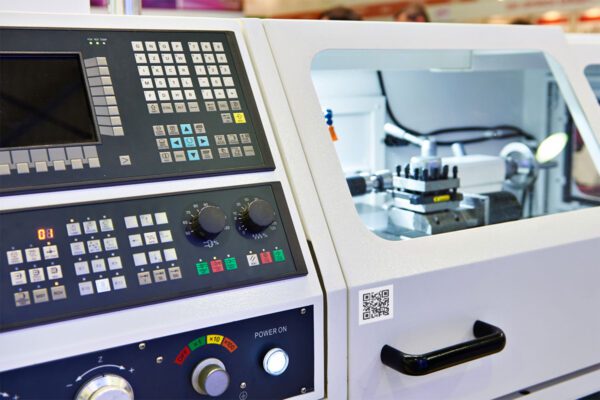
Organizations across industries rely on a wide range of physical assets to operate efficiently. Without an efficient way to track them, maintenance teams struggle to locate equipment and inventory items, respond to issues quickly, or maintain accurate records. Asset tagging, when combined with a computerized maintenance management system (CMMS), provides a reliable way to track your asset maintenance tasks. In this article, we explore how asset tagging improves asset visibility to manage assets more effectively throughout their lifecycle.
What is Asset Tagging?
Asset tagging is the process of labeling physical assets with unique identification – such as barcodes or QR codes – to support asset management. It helps organizations increase visibility of their owned assets in order to improve asset tracking.
What is an Asset Tag?

As the term implies, asset tagging involves the use of asset tags. Asset tags are labels used to identify an organization’s physical assets using a unique number. They are physically attached in visible, accessible locations so technicians can easily view, scan, or retrieve data from them. Asset tags come in many forms:
- Barcode labels: Also called 1-dimensional (1D) barcodes, barcode labels consist of vertical lines and spaces that represent alphanumeric data.
- Quick Response (QR) codes: A type of 2-dimensional (2D) barcodes comprised of symbols and shapes, capable of encoding a variety of data including alphanumeric characters, website URLs, images, and files.
- Radio Frequency Identification (RFID) tags: Small electronic devices containing a microchip and antenna used for wireless identification and tracking.
- Near Field Communication (NFC) tags: Similar in technology to RFID, NFC tags wirelessly transmit data within close proximity to NFC-enabled devices.
- Global Positioning System (GPS) tags: Small electronic devices equipped with a GPS receiver, used to transmit a precise global location.
Depending on the type of tag, technicians use a barcode reader, smartphone app, or other scanning device to read asset tags and retrieve information about the asset.
Why Asset Tagging is Important
Maintenance teams are responsible for managing anywhere from hundreds to tens of thousands of assets – including equipment, spare parts, and tools. Not only does the sheer volume make manual tracking difficult, many assets may be similar to one another. The asset tagging process ensures that you have an accurate picture of your organization’s owned assets and can more effectively track assets throughout their lifecycle.
When integrated with computerized maintenance management system (CMMS) software or other asset tracking systems, technicians are able to quickly access critical information about assets including manufacturer details, service history, and maintenance documentation. Having such information at their fingertips allows maintenance teams to respond to breakdowns faster, systematically diagnose the causes of equipment failures, and reduce downtime.
Benefits of Asset Tagging
Asset tagging provides numerous benefits related to asset tracking and maintenance management:
- Improve asset visibility: Easily identify what assets you have as well as their locations, conditions, and operational statuses.
- Easily identify assets: Prevent confusion and errors by distinguishing assets from one another through unique naming and numbering conventions.
- Quickly retrieve critical asset data: Access comprehensive data about an asset by scanning its tag.
- Reduce data entry errors: Minimize mistakes from manual data entry by scanning a tag to input asset information.
- Track assets in real-time: Monitor the location and movement of moveable assets in real-time with location-enabled tags.
- Improve accountability: Implement a check-in, check-out system to identify where assets are located, who is in possession of them, and when they were taken/returned.
- Reduce loss or theft: Track asset location in real-time to prevent unauthorized access or movement.
How to Implement an Asset Tagging System

Asset tagging is a powerful tool that greatly increases your ability to track assets and their maintenance needs. Though it requires a little time and effort up front, the payoffs of asset tagging far outweigh the investment. Below is an overview of the steps involved in implementing an asset tagging system for your facility.
1. Create an Asset Register
An asset register is a formal list of all maintenance assets your organization owns or manages. Creating an asset register ensures that you have a complete picture of all assets and reduces the likelihood that assets will be ignored or duplicated. In addition to an ID, record an asset’s name, location, condition, and any other critical details. This is easily done in a CMMS.
2. Determine Which Assets to Tag
Though asset tagging has many benefits, it is often not practical or worthwhile to tag every single asset. Determining which assets are candidates for tagging relies on factors such as your organization’s goals, budget constraints, or the types of assets being considered. Below are some factors that might influence your decision on whether to tag an asset
- Criticality: Critical assets are those whose failure or downtime greatly disrupt day-to-day operations or threaten safety. Assess an asset’s risk to help with this determination.
- Value: Prioritize assets that are expensive to repair, replace, or are financially significant. For example, only tag assets that are above a set asset value.
- Maintenance requirements: Consider assets that undergo regular maintenance, have specific calibration requirements, or require frequent inspection to stay on top of preventive maintenance.
- Compliance requirements: Tag any assets that are required, by law, to be tracked and documented.
- Frequency of use: Assets that are frequently used require more frequent maintenance, making them ideal candidates for asset tracking. Likewise, tagging assets that move frequently ensures they are available when needed.
- Frequency of failure: Identifying and tagging assets allows you to link historical performance to a particular asset, allowing you to monitor performance, analyze trends, and make data-backed repair vs. replace decisions.
3. Assign a Unique ID Number
The main benefit of asset tagging is to be able to accurately identify assets for tracking purposes. Therefore, each asset must have a unique identifier. Your organization should develop an asset naming convention that is logical and makes assets easy to recognize from the ID alone.
Asset IDs vs. Serial Numbers
Though serial numbers are a way to uniquely identify assets, it is advised not to use serial numbers for asset IDs, as they serve different goals.
Serial numbers are assigned by manufacturers to distinguish one unit from another or for warranty purposes. Their format is not standardized and can vary between manufacturers, even for similar equipment. Further, serial numbers have no meaning to your organization.
On the other hand, a strategic, internally-crafted naming convention allows you to build meaning into asset IDs, making it easier for teams to quickly identify and communicate about specific assets.
4. Determine the Type of Asset Tag Required
Asset tags come in a variety of shapes, sizes, and materials to fit an infinite amount of applications. When figuring out what type of asset tags best fit your needs, consider the following questions:
- What material is the surface to which the asset tag is to be applied?
- What environmental conditions (i.e., heat, moisture, chemicals, etc.) are your assets exposed to?
- What type of tag technology do you need to meet your asset tracking goals?
- How much data needs to be encoded on the tag?
- What types of asset tags are supported by the CMMS or asset tracking system?
5. Enter Assets into Your CMMS
If not already present in your CMMS, enter the assets from your register into the system. Include any information required by the system, as well as essential information such as manufacturer, serial number, and location. The more data you provide, the more effective the CMMS will be in building complete maintenance records.
6. Apply the Asset Tags
Affix tags in a secure, accessible location on each asset. The type of tag chosen earlier may determine how the tag is attached and where it is placed.
7. Train Your Team
Once asset tags are in place, you must educate your team on the purpose and significance of the tags and how to use them in their maintenance process. Train your team how to use any scanning devices, advanced CMMS features, or other software required for the asset tagging system. Be sure to document policies for your asset tagging system, such as who can create new tags, how naming conventions are applied, and how changes should be handled.
Manage and Track Your Assets with FTMaintenance Select
Accurate asset identification is a key component of asset tracking. Asset tags uniquely identify your assets, ensuring that failures and maintenance activities are attributed correctly. When used in tandem with asset tracking software, like FTMaintenance Select, you can save time searching for asset information, entering data, and managing asset maintenance and repairs. Request a demo today to learn how FTMaintenance Select can streamline your asset tracking and maintenance operations.